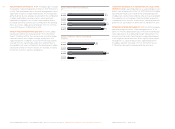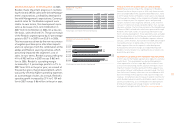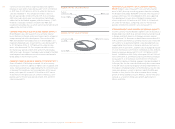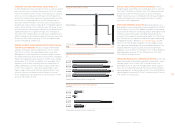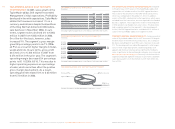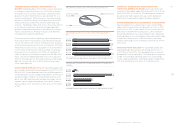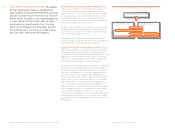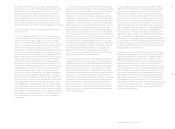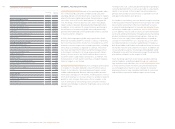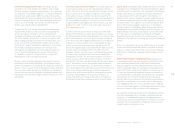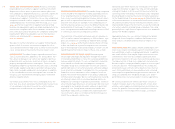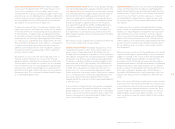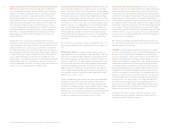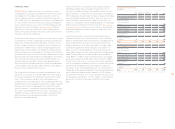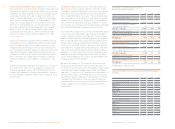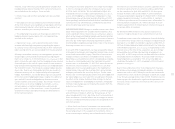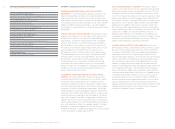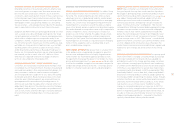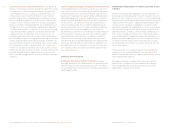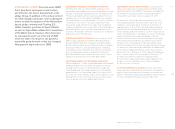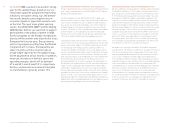Reebok 2007 Annual Report Download - page 112
Download and view the complete annual report
Please find page 112 of the 2007 Reebok annual report below. You can navigate through the pages in the report by either clicking on the pages listed below, or by using the keyword search tool below to find specific information within the annual report.108
ANNUAL REPORT 2007 --- adidas Group GROUP MANAGEMENT REPORT – OUR FINANCIAL YEAR - Risk and Opportunity Report
SOCIAL AND ENVIRONMENTAL RISKS We have a continuing
responsibility to our workers, suppliers and the environment.
Malpractice in these areas, in particular human rights viola-
tions and dubious employment practices, can have a signifi cant
impact on the reputation and operational effi ciency of our
Group and our suppliers. To limit this risk, we have established
workplace standards to which suppliers must conform before
and during business relationships with the Group. see Sustain-
ability, p. 065 Internal inspections of supplier factories verifi ed
by extensive independent audits are conducted regularly. In the
event of non-compliance with these standards, we develop
joint action plans and set deadlines for compliance and further
improvement. When these deadlines are not met, business
relations are terminated. see Sustainability, p. 065, and www.adidas-
Group.com / sustainability
We expect to further strengthen our sup plier monitoring pro-
gram in 2008. As a result, we continue to regard the risk of
social and environmental malpractice as likely in only isolated
cases and we believe the potential fi nancial impact is low.
NATURAL RISKS The adidas Group is exposed to external risks
such as natural disasters, epidemics, fi re and accidents. Fur-
ther, physical damage to our own or our suppliers’ premises,
production units, warehouses and stock in transit can lead to
property damage and business interruption. These risks are
mitigated by ample loss prevention measures such as working
with reliable suppliers and logistics providers who guarantee
high safety standards and disaster recovery plans. In addition
to the considerable insurance coverage we have secured, the
Group has also implemented contingency plans to minimize
potential negative effects.
Our overall assessment of this risk is unchanged versus the
prior year. As a result, we believe the likelihood of natural risks
is low and expect only minor fi nancial loss after insurance
compensation should natural risks materialize.
STRATEGIC AND OPERATIONAL RISK
S
PORTFOLIO INTEGRATION RISKS The adidas Group is exposed
to risks related to the integration of newly acquired businesses.
In our ongoing initiatives to integrate the Reebok brand, we
face a risk of overestimating potential revenue and cost syner-
gies as well as organizational execution risks. Organizational
execution risks relate, for example, to the standardization of
functional business processes across the different brands and
harmonization of the Group’s IT systems. To mitigate these
risks, we implemented a dedicated controlling function in 2006
to continuously oversee our integration activities.
The realization of the projected revenue and cost synergies in
2007, as well as internal transparency on 2008 initiatives, sup-
ports our confi dence in achieving our medium-term synergy
targets. see Outlook, p. 118 We therefore believe there continues
to be a low likelihood of portfolio integration risk occurrence.
Due to the magnitude of projected synergies, however, we still
regard the potential fi nancial impact of these risks as high.
RISKS FROM LOSS OF BRAND IMAGE Maintaining and
enhancing brand image and reputation through the creation
of strong brand identities is crucial for sustaining and driving
revenue and profi t growth. It is also an important credential
as we extend our brands into new categories and regions.
The adidas Group faces considerable risk if we are unable to
uphold high levels of consumer awareness, affi liation and pur-
chase intent for our brands. To mitigate this risk, we have de-
fi ned clear mission statements, values and goals for all our
brands. These form the foundation of our product and brand
communication strategies. We also continually refi ne our prod-
uct offering to meet shifts in consumer demand and to con-
temporize our offering to respond to current trends. Central to
all our brand image initiatives is ensuring clear and consistent
messaging to our targeted consumer audience, in particular
at point-of-sale. Strong brand momentum at adidas and
TaylorMade-adidas Golf, as evidenced in improving market
research results, gives us confi dence that brand image risk
in both these segments remains low.
During the past twelve months, we introduced our fi rst post-
acquisition initiatives to support our long-term brand image
strategy for Reebok. In 2008, we will increase our efforts by
launching several new product technologies and a new global
brand campaign to improve the overall consumer experience
for the Reebok brand. see Reebok Strategy, p. 050 Nevertheless, due
to the current weakness of the brand in North America and the
UK, and the pos sibility that our revitalization initiatives fail to
improve brand image in the short term, we view the likelihood
of a further reduction in brand image as medium. This could
potentially have a high fi nancial impact on the sales and profi t-
ability of the Reebok segment.
Aggregating these risks, we continue to believe that brand
image risk for the Group has a medium likelihood of occur-
rence and also a medium potential fi nancial impact on our
Group.
OWN-RETAIL RISKS New adidas, Reebok and Rockport own-
retail stores require considerable up-front investment in furni-
ture and fi ttings as well as ongoing maintenance. In addition,
own-retail activities often require longer-term lease or rent
commitments. Own retail also employs signifi cantly more
personnel in relation to net sales than our wholesale business.
The higher portion of fi xed costs compared to our wholesale
business implies a larger profi tability impact in cases of signif-
icant sales declines. The Group minimizes this risk by only
entering into lease contracts with a duration of less than ten
years. Store performance is measured by a retail scorecard
consisting of nine quantitative key performance indicators. All
shops are ranked by their weighted average score. Under-
performing stores are restructured or closed as appropriate.
We continue to believe the likelihood of major closures is
medium. However, due to the strong growth of own-retail
activities and a rapidly consolidating retail environ ment, we
assess the potential fi nancial impact from these closures,
which may also involve impairment charges, as medium.


